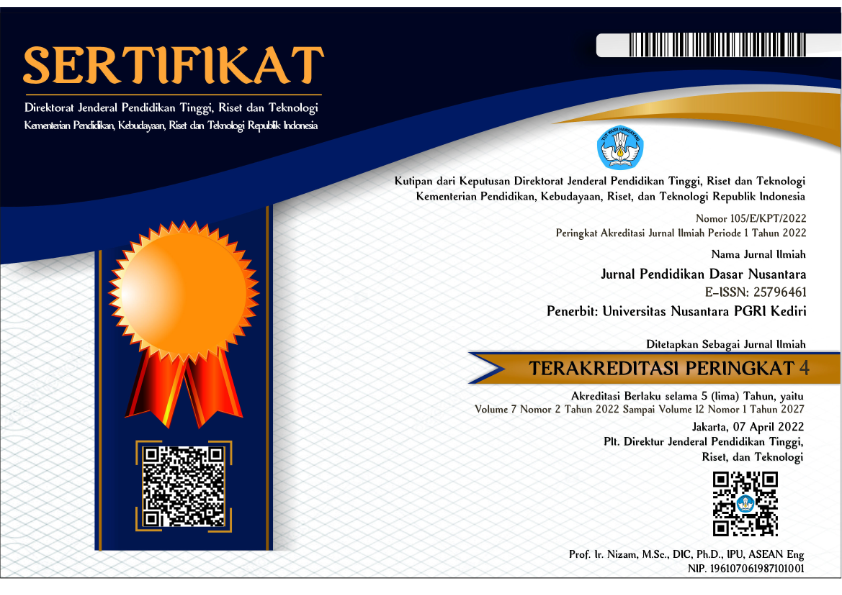TINDAK KOMUNIKASI PEMBELAJARAN DI SEKOLAH DASAR
DOI:
https://doi.org/10.29407/jpdn.v3i2.11785Keywords:
students' meaning, instructional communication, elementary schoolAbstract
The objective of the study is to describe the form of learning communication in the classroom and the meaning of the students to the learning communication on verbal, non-verbal, interpersonal, group, and public communication. The research used qualitative approach with phenomenology study design. The result of the research is the expression of thoughts and feelings of students to verbal communication is easy to understand the material and dare to ask. The expression of students' thoughts and feelings toward non-verbal communication is fear when teachers speak with high intonation, but students feel happy and feel loved by the teacher's touch. Expression of thoughts and feelings of students to interpersonal communication is a feeling of fun when teachers ask news, the state of self, health, birthday celebrations, and attention when experiencing bullying. Expression of thoughts and feelings of students to group communication is a feeling of fun when learning groups, feelings of freedom to discuss and ask the task personally to the teacher and discipline when grouping students who are busy in the classroom to be advised teachers. Expression of thoughts and feelings of students to public communication is easy to understand the subject matter and feelings of pleasure when inserted humor in the lecture method.
Keywords: students' meaning, instructional communication, elementary school
Downloads
References
Darmadi, D. 2015. Hubungan Komunikasi Guru terhadap Prestasi Belajar Siswa pada Mata Pelajaran Sosiologi di SMU Negeri 5 Samarinda, dalam jurnal eJournal Ilmu Komunikasi, 3(3) 211-225
Hanurawan, F. 2012. Metode Penelitian Kualitatif dalam Ilmu Psikologi. Surabaya: Pusat Studi Peningkatan Kinerja Masyarakat LPPM Universitas Airlangga Kampus C.
Iriantara, Yosal. 2014. Komunikasi Pembelajaran Interaksi, Komunikatif dan Edukatif dalam Kelas. Bandung: PT Simbiosa Rekatama Media
Sitompul, N. C. 2012. Perilaku Komunikasi Non Verbal Guru dalam Kelas Pembelajaran: Maknanya bagi Siswa SMA, dalam Jurnal Jurnal Pendidikan dan Pembelajaran, 19 (1) 38-49
Widodo, W. 2016. Wujud Kenyamanan Belajar Siswa, Pembelajaran Menyenangkan, dan Pembelajaran Bermakna di Sekolah Dasar, dalam Jurnal Ar-Risalah, XVIII(2) 22-37
Zeky, C. P. (2009). The importance of non-verbal communication in classroom management, dalam jurnal Procedia-Social and Behavioral Sciences, 1(1), 1443-1449, (Online), (http://www.sciencedirect.com/science/article/pii/S1877042809002572), diakses 1 Juni 2016.
Downloads
Published
Issue
Section
License
Authors who publish with this journal agree to the following terms:
- Copyright on any article is retained by the author(s).
- The author grants the journal, the right of first publication with the work simultaneously licensed under a Creative Commons Attribution License that allows others to share the work with an acknowledgment of the work’s authorship and initial publication in this journal.
- Authors are able to enter into separate, additional contractual arrangements for the non-exclusive distribution of the journal’s published version of the work (e.g., post it to an institutional repository or publish it in a book), with an acknowledgment of its initial publication in this journal.
- Authors are permitted and encouraged to post their work online (e.g., in institutional repositories or on their website) prior to and during the submission process, as it can lead to productive exchanges, as well as earlier and greater citation of published work.
- The article and any associated published material is distributed under the Creative Commons Attribution-ShareAlike 4.0 International License

































